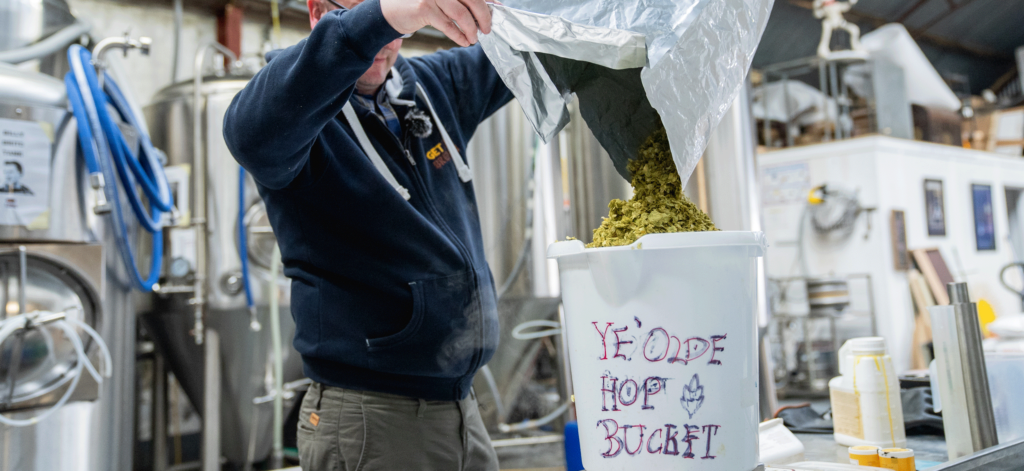Using Hops In The Brewhouse

Geterbrewed has been working on hop blog posts recently to provide more knowledge about hops’ use in the brewhouse. Many modern-day craft brewers are going for the juice bomb effect. With loads of late whirlpool hopping, hop stands at different temperatures than huge x amount per litre of dry hops. On the opposite side of that parameter; traditional german breweries add 60/70% of their hops at first wort. Some brewers add hops in the mash, first wort, the kettle, the whirlpool and the fermenter. So what works best for you?
There is much more to brewing with hops than simply just working out the IBUs when hops are added. It’s important to recognise how the hops will affect the finished beer.
There are multiple types of alpha acids. The main types that brewers are interested in are Humulone, Co Hululone and Adhumulone.
The above alpha acids are isomerised in wort by heat, and each is transferred into two forms. The result being six iso-alpha acids (cis-iso-humulone, trans-iso-humulone, cis-iso-cohumulone, trans-iso-cohumulone, cis-iso-adhumulone and trans-iso-adhumulone)
Interesting Hop Infomation
Alpha acids aren’t really soluble in beer and aren’t bitter. In contrast, iso-alpha acids are intensely bitter, at least four times more bitter than alpha acids. So Iso alpha acids provide bitterness, stabilise beer foam, and inhibit the growth of bacteria.
Hop Scientists have identified that higher percentages of co-humulone produce a harsher bitterness. Hence the demand for hops with low amounts of co-humulone. This has to be balanced as low-level co-humulone hops wouldn’t efficiently achieve high levels of bitterness.
Co-Humulone and Humulone levels vary between 20-50% each in different hop varieties, while Adhumulone will be 10-15%. These alpha acids are important for flavour stability in packaged beer. Traditionally, hopped beers comprise 68% cis alpha acids (perceived bitterness) and 32% trans alpha acids (these alpha deteriorate much faster). Many factors will affect the degradation of these alpha acids. However, cold storage of your packaged beer will slow this down greatly.
Some brewers are starting to brew with pre-isomerised hop extract. Geterbrewed recently started to sell Isohop in 1-litre format for this purpose. This achieves a 55% utilisation as opposed to 30%. Iso Hop contains a higher % of Cis- Isomers and is more stable.
Other Factors
Beta acids generally are not soluble. However, some research has shown oxidation reactions with beta acids. This creates halipinic acid in the boil and perceived bitterness because of its transformation. Oxidation reactions occur due to hops not being stored correctly.
Many variables will affect perceived bitterness levels in beer; for e.g. some malts will add bitterness like roasted malt. It can be said that beer brewed with more calcium sulphate in the water will be recognised in the taste as having a crisper hop character, while those beers that are higher in calcium carbonate exhibit a harsher bitterness.
The temperature that beer is served at may highlight or suppress the bitterness, with colder temperatures being the suppressant. The level of polyphenols also affects the perception of bitterness.
IBU utilisation is complex to measure, and results from different locations will vary greatly depending on what formula you use to calculate. Tinseth formula would be the most popular.
IBU categorisation was created to help brewers brew a beer with a consistent bitterness level. So how do they measure this? Acidifying and extracting a sample of beer with iso-octane, then taking an absorbance reading at a specific wavelength with ultraviolet light is a high tec lab test, not one we as brewers can routinely carryout in the brewhouse.
Utilisation of Hops
There are many variables to affect the utilisation of hops; for e.g. change in the length of the boil and the hop utilisation will change. Other factors affecting utilisation include:
- Type of hop – e.g. pellets are 10% more efficient than leaf and BBC enhanced t90 pellets are 30% more efficient than leaf
- Shape/size of the kettle – how the hops move around during the boil
- The gravity of the wort – the higher the og the lower the utilisation
- The temperatures during the boil
- The pH, salts & minerals in the water
Hop utilisation equals the amount of iso-alpha acids found in the finished beer. Brewers can expect to lose about 50% of iso-alpha acids on the hot side and a further 20% during fermentation and packaging.
Different hops require different boiling times. Experimentation with blending hop varieties and splitting the addition times are best practices in our opinion, to build layers of hop flavour into your beer. Longer post-boil stands will produce more hop flavour, aroma and perceived bitterness.